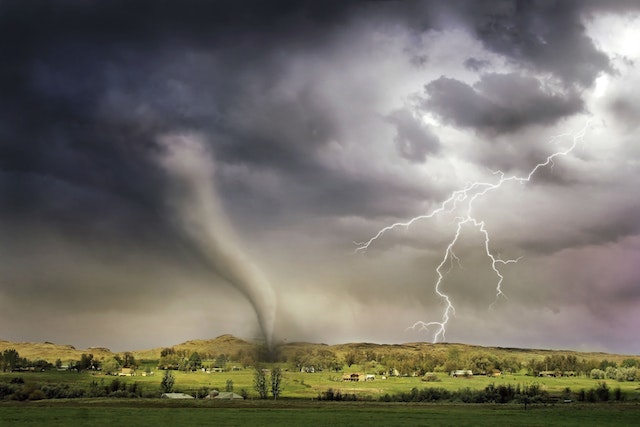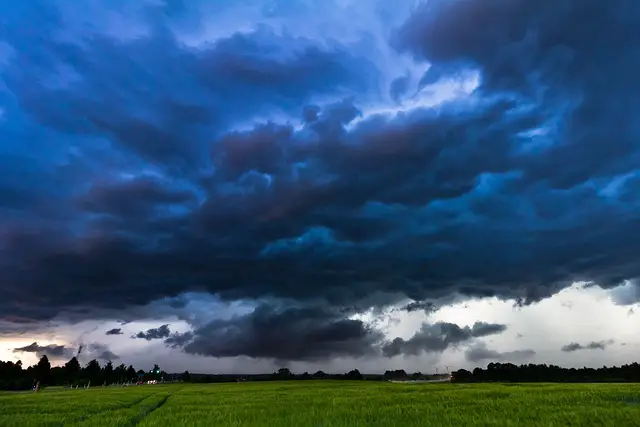A squall is a sudden, sharp increase in wind speed that lasts for a short period of time, typically less than an hour. A storm is a more general term that can refer to any severe weather event, such as a thunderstorm, blizzard, or hurricane, that may last for several hours or even days.
What is a squall?
(Image by Erich Westendarp from Pixabay )

A squall is a strong, sudden, brief burst of wind. It is usually associated with a front or thunderstorm. Squalls can last from a few minutes to an hour and can cause damage and disrupt travel.
What is a storm?
(Photo by Ralph W. lambrecht at pexles.com)

A storm is a disturbance of the atmosphere characterized by strong winds and usually by rain, thunder, lightning, or snow. Storms are caused by atmospheric disturbances such as fronts, troughs, or low-pressure areas.
The difference between squall and storm
A storm is a meteorological event characterized by high winds and typically accompanied by precipitation. A squall is a sudden, sharp increase in wind speed that is often associated with severe weather conditions.
When to expect a squall or storm
A squall is typically defined as a sudden, sharp increase in wind speed that lasts for at least minutes. A storm, on the other hand, is a sustained period of high winds and usually accompanied by other forms of severe weather, such as heavy rain or snow, thunder and lightning. So if you’re wondering when to expect a squall or storm, the answer largely depends on the time of year and your location.
In general, storms are more common in the late fall and winter months in temperate regions like the United States. That’s because they are often associated with low-pressure systems that form along cold fronts. As these systems move eastward from the Rockies, they can pick up moisture from the Gulf of Mexico and Atlantic Ocean, which can lead to severe weather conditions.
If you live in an area that is prone to hurricanes, you’ll need to be on the lookout for squalls and storms during hurricane season, which runs from June 1 to November 30. These systems often form in advance of the hurricane itself and can bring dangerous wind gusts, heavy rains, and even tornadoes.
So no matter where you live, it’s important to be aware of the potential for squalls and storms throughout the year. By understanding when they are most likely to occur in your area, you can be better prepared if one does strike.
How to stay safe during a squall or storm
A squall is a sudden, sharp increase in wind speed that is often associated with precipitation. A storm is a weather event that is characterized by high winds and usually by more severe precipitation.
- During a squall or storm, it is important to stay safe. Here are some tips:
- Stay indoors if possible. If you must go outside, avoid being in open spaces where you could be blown away by the wind.
- Be aware of flying debris. High winds can pick up objects and carry them through the air.
- Watch for falling trees or branches. Stay away from them if possible.
- Be careful driving. High winds can make driving difficult and dangerous, especially if you are driving a high-profile vehicle like a truck or SUV. Slow down and be extra cautious when driving in a squall or storm.
What does squall mean in weather?
According to the National Weather Service, a squall is “a sudden, sharp increase in wind speed that is usually associated with active weather, such as thunderstorms.” Storms, on the other hand, are “large-scale disturbances of the atmosphere.” So while all storms are squalls, not all squalls are storms.
Squalls can last anywhere from a few minutes to an hour, and their winds can range from 40 to 60 miles per hour. But because they’re often associated with severe weather conditions like thunderstorms, tornadoes, and hurricanes, it’s important to take them seriously and be prepared for whatever they might bring.
If you’re ever caught in a squall, the best thing to do is to find shelter immediately. If you’re in a car, pull over to the side of the road and wait for the squall to pass. If you’re outdoors, try to find a low-lying area or somewhere that will offer some protection from the wind. And if you’re on a boat, head for shore as quickly as possible.
What are the types of storms?
There are several types of storms: Thunderstorms, Tropical storms, Winter storms, and Hurricanes.
Thunderstorms are the most common type of storm. They are usually caused by a cold front moving through an area of warm, moist air.
Tropical storms are typically found in the tropics and generally form over warm ocean waters.
Winter storms occur when cold air masses meet and can produce a variety of precipitation, including snow, sleet, and freezing rain.
Hurricanes form over warm ocean waters and typically bring heavy rains, strong winds, and flooding to coastal areas.
What is the strongest storm type?
There are many types of storms, but the strongest storm type is the tornado. Tornadoes are violent rotating columns of air that extend from a thunderstorm to the ground. They can cause extensive damage to property and even loss of life.
What is the most deadliest type of storm?
The most deadly type of storm is a tornado. Tornadoes are large, rotating columns of air that extend from the base of a thunderstorm to the ground. They are extremely destructive and can cause death and destruction in a matter of minutes.
Which country has the most storms?
There is no definitive answer to this question as it largely depends on the definition of a storm. However, according to the National Weather Service, the United States experiences the most thunderstorms in the world. On average, there are about 16 million thunderstorms each year in the U.S., which is about 44% of all thunderstorms globally.
Which clouds mean danger?
There are three main types of clouds that indicate danger: Cumulonimbus, Cirrus, and Stratus clouds.
Cumulonimbus clouds are large, dark, and often described as looking like a thunderhead. These clouds can produce heavy rain, strong winds, hail, and even tornadoes.
Cirrus clouds are high, thin, wispy clouds that are often the first sign of an oncoming storm. They can sometimes be followed by cumulonimbus clouds.
Stratus clouds are low-lying and often gray or black in color. They can produce light rain or snow and sometimes indicate severe weather conditions ahead.
How do you identify a squall?
A squall is a sudden, sharp increase in wind speed that is often associated with thunderstorms. Squalls can last for a few minutes or up to an hour and typically occur when cold air rushes into an area of warm, moist air. This interaction between different temperature air masses can create strong winds and often lead to dangerous weather conditions.
Frequently asked questions about a squall
How strong is a squall?
A squall is a sudden, sharp increase in wind speed that lasts for a minute or more. Storms, on the other hand, are sustained periods of high winds and often last for several hours. While squalls can certainly be disruptive, they typically don’t pack the same punch as storms.
Why do squalls happen?
Squalls happen when the wind abruptly increases to at least 16 knots (18 mph) and typically last for a minute or two. They are often associated with thunderstorms, so you might see darkening skies, hear thunder in the distance, and feel a drop in air pressure just before a squall hits.
How big is a squall?
The size of a squall can vary greatly depending on the strength of the winds and the amount of precipitation. A squall line may extend for hundreds of miles, while a weak squall may only last for a few minutes.
Where do squalls occur?
Squalls are sudden, sharp increases in wind speed that typically last for a few minutes. They can occur anywhere in the world where there is a large body of water, such as an ocean, lake, or river. Typically, squalls occur in the spring and summer months when the air is warm and moist.
Can you fly through a squall line?
A squall line is a line of thunderstorms that can stretch for hundreds of miles. The storms in a squall line may not be as strong as those in a supercell, but they can still produce high winds and heavy rain.
While it is possible to fly through a squall line, it is not recommended. Squall lines can produce turbulence and downbursts that can be dangerous for aircraft. If you must fly through a squall line, make sure you have the latest weather information and stay alert for changes in conditions.
Featured Image By – Image by Tobias Hämmer from Pixabay








